Strategic Importance of HRD: BUSM4592 Report - University Name
VerifiedAdded on 2022/11/26
|9
|2129
|226
Report
AI Summary
This report provides a comprehensive analysis of the strategic importance of Human Resource Development (HRD) within organizations. It begins with an introduction to HRD, defining its role in employee training and development to enhance knowledge, skills, and abilities. The report then explores the application of HRD concepts, including HR competency, flexibility, and continuous performance improvement, highlighting their impact on organizational effectiveness and innovation. The identification of HRD needs is discussed, emphasizing the importance of adapting to a rapidly changing business environment and developing employees for personal and organizational growth. The report further examines the comprehension of HRD, including its implementation stages and the integration of HRD policies with organizational strategies. Finally, it addresses various HRD issues, such as the challenges faced by small businesses and the need for innovation, concluding with the overall significance of HRD in strategic planning and organizational success. The report references key academic sources to support its findings.

Running head: STRATEGIC IMPORTANCE OF HRD
TITLE
Name of the Student:
Name of the University:
Author Note:
TITLE
Name of the Student:
Name of the University:
Author Note:
Paraphrase This Document
Need a fresh take? Get an instant paraphrase of this document with our AI Paraphraser
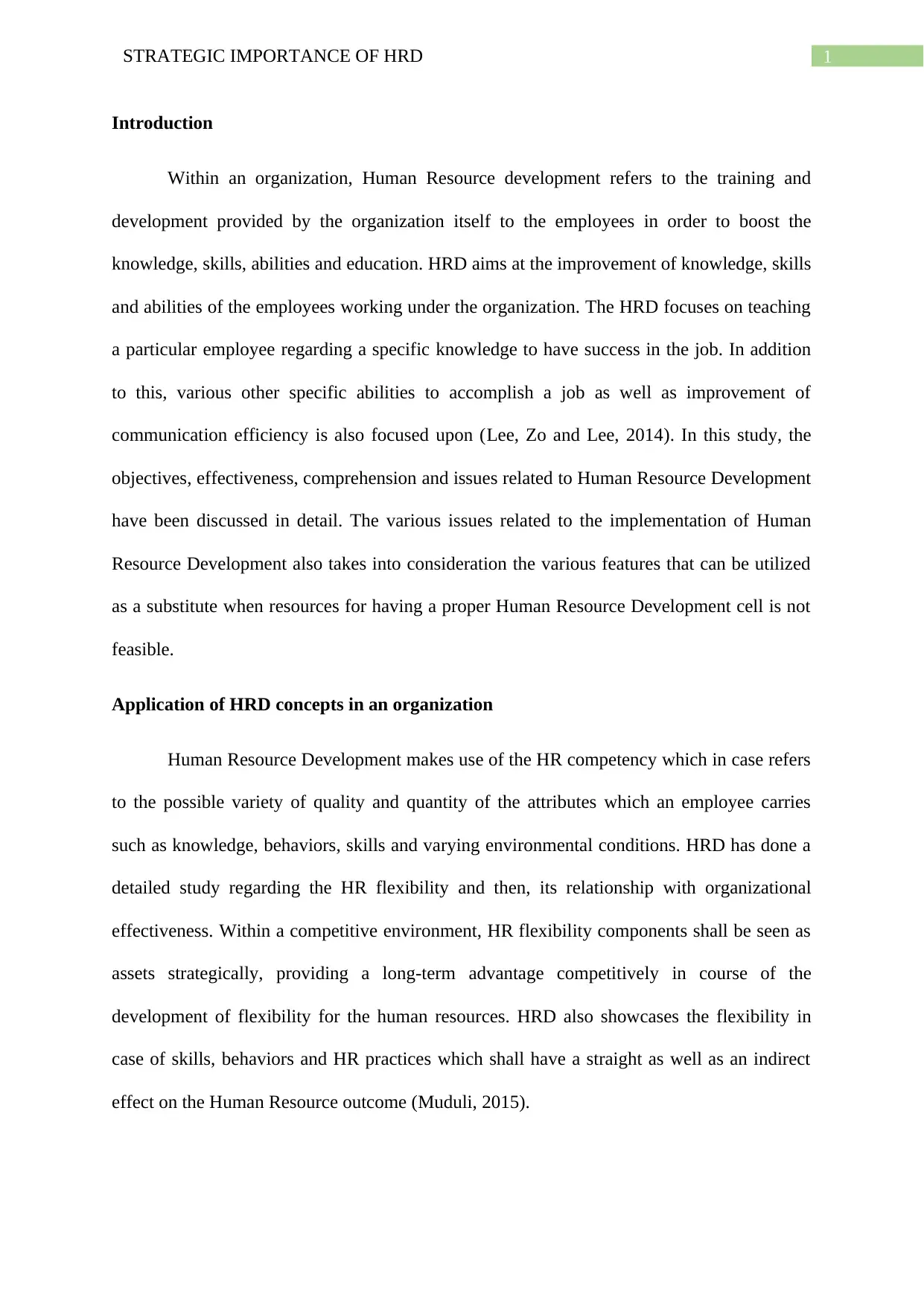
1STRATEGIC IMPORTANCE OF HRD
Introduction
Within an organization, Human Resource development refers to the training and
development provided by the organization itself to the employees in order to boost the
knowledge, skills, abilities and education. HRD aims at the improvement of knowledge, skills
and abilities of the employees working under the organization. The HRD focuses on teaching
a particular employee regarding a specific knowledge to have success in the job. In addition
to this, various other specific abilities to accomplish a job as well as improvement of
communication efficiency is also focused upon (Lee, Zo and Lee, 2014). In this study, the
objectives, effectiveness, comprehension and issues related to Human Resource Development
have been discussed in detail. The various issues related to the implementation of Human
Resource Development also takes into consideration the various features that can be utilized
as a substitute when resources for having a proper Human Resource Development cell is not
feasible.
Application of HRD concepts in an organization
Human Resource Development makes use of the HR competency which in case refers
to the possible variety of quality and quantity of the attributes which an employee carries
such as knowledge, behaviors, skills and varying environmental conditions. HRD has done a
detailed study regarding the HR flexibility and then, its relationship with organizational
effectiveness. Within a competitive environment, HR flexibility components shall be seen as
assets strategically, providing a long-term advantage competitively in course of the
development of flexibility for the human resources. HRD also showcases the flexibility in
case of skills, behaviors and HR practices which shall have a straight as well as an indirect
effect on the Human Resource outcome (Muduli, 2015).
Introduction
Within an organization, Human Resource development refers to the training and
development provided by the organization itself to the employees in order to boost the
knowledge, skills, abilities and education. HRD aims at the improvement of knowledge, skills
and abilities of the employees working under the organization. The HRD focuses on teaching
a particular employee regarding a specific knowledge to have success in the job. In addition
to this, various other specific abilities to accomplish a job as well as improvement of
communication efficiency is also focused upon (Lee, Zo and Lee, 2014). In this study, the
objectives, effectiveness, comprehension and issues related to Human Resource Development
have been discussed in detail. The various issues related to the implementation of Human
Resource Development also takes into consideration the various features that can be utilized
as a substitute when resources for having a proper Human Resource Development cell is not
feasible.
Application of HRD concepts in an organization
Human Resource Development makes use of the HR competency which in case refers
to the possible variety of quality and quantity of the attributes which an employee carries
such as knowledge, behaviors, skills and varying environmental conditions. HRD has done a
detailed study regarding the HR flexibility and then, its relationship with organizational
effectiveness. Within a competitive environment, HR flexibility components shall be seen as
assets strategically, providing a long-term advantage competitively in course of the
development of flexibility for the human resources. HRD also showcases the flexibility in
case of skills, behaviors and HR practices which shall have a straight as well as an indirect
effect on the Human Resource outcome (Muduli, 2015).
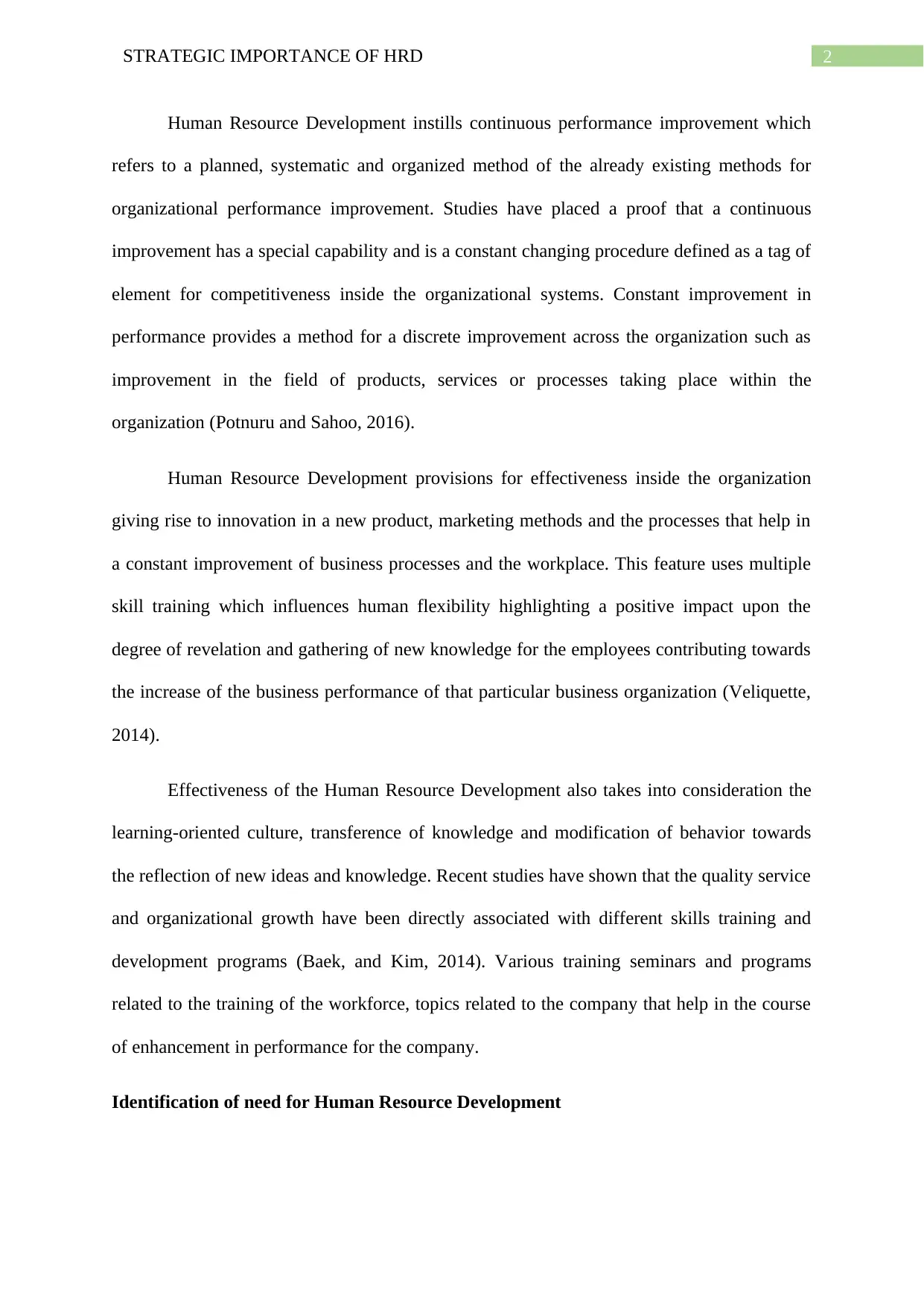
2STRATEGIC IMPORTANCE OF HRD
Human Resource Development instills continuous performance improvement which
refers to a planned, systematic and organized method of the already existing methods for
organizational performance improvement. Studies have placed a proof that a continuous
improvement has a special capability and is a constant changing procedure defined as a tag of
element for competitiveness inside the organizational systems. Constant improvement in
performance provides a method for a discrete improvement across the organization such as
improvement in the field of products, services or processes taking place within the
organization (Potnuru and Sahoo, 2016).
Human Resource Development provisions for effectiveness inside the organization
giving rise to innovation in a new product, marketing methods and the processes that help in
a constant improvement of business processes and the workplace. This feature uses multiple
skill training which influences human flexibility highlighting a positive impact upon the
degree of revelation and gathering of new knowledge for the employees contributing towards
the increase of the business performance of that particular business organization (Veliquette,
2014).
Effectiveness of the Human Resource Development also takes into consideration the
learning-oriented culture, transference of knowledge and modification of behavior towards
the reflection of new ideas and knowledge. Recent studies have shown that the quality service
and organizational growth have been directly associated with different skills training and
development programs (Baek, and Kim, 2014). Various training seminars and programs
related to the training of the workforce, topics related to the company that help in the course
of enhancement in performance for the company.
Identification of need for Human Resource Development
Human Resource Development instills continuous performance improvement which
refers to a planned, systematic and organized method of the already existing methods for
organizational performance improvement. Studies have placed a proof that a continuous
improvement has a special capability and is a constant changing procedure defined as a tag of
element for competitiveness inside the organizational systems. Constant improvement in
performance provides a method for a discrete improvement across the organization such as
improvement in the field of products, services or processes taking place within the
organization (Potnuru and Sahoo, 2016).
Human Resource Development provisions for effectiveness inside the organization
giving rise to innovation in a new product, marketing methods and the processes that help in
a constant improvement of business processes and the workplace. This feature uses multiple
skill training which influences human flexibility highlighting a positive impact upon the
degree of revelation and gathering of new knowledge for the employees contributing towards
the increase of the business performance of that particular business organization (Veliquette,
2014).
Effectiveness of the Human Resource Development also takes into consideration the
learning-oriented culture, transference of knowledge and modification of behavior towards
the reflection of new ideas and knowledge. Recent studies have shown that the quality service
and organizational growth have been directly associated with different skills training and
development programs (Baek, and Kim, 2014). Various training seminars and programs
related to the training of the workforce, topics related to the company that help in the course
of enhancement in performance for the company.
Identification of need for Human Resource Development
⊘ This is a preview!⊘
Do you want full access?
Subscribe today to unlock all pages.

Trusted by 1+ million students worldwide
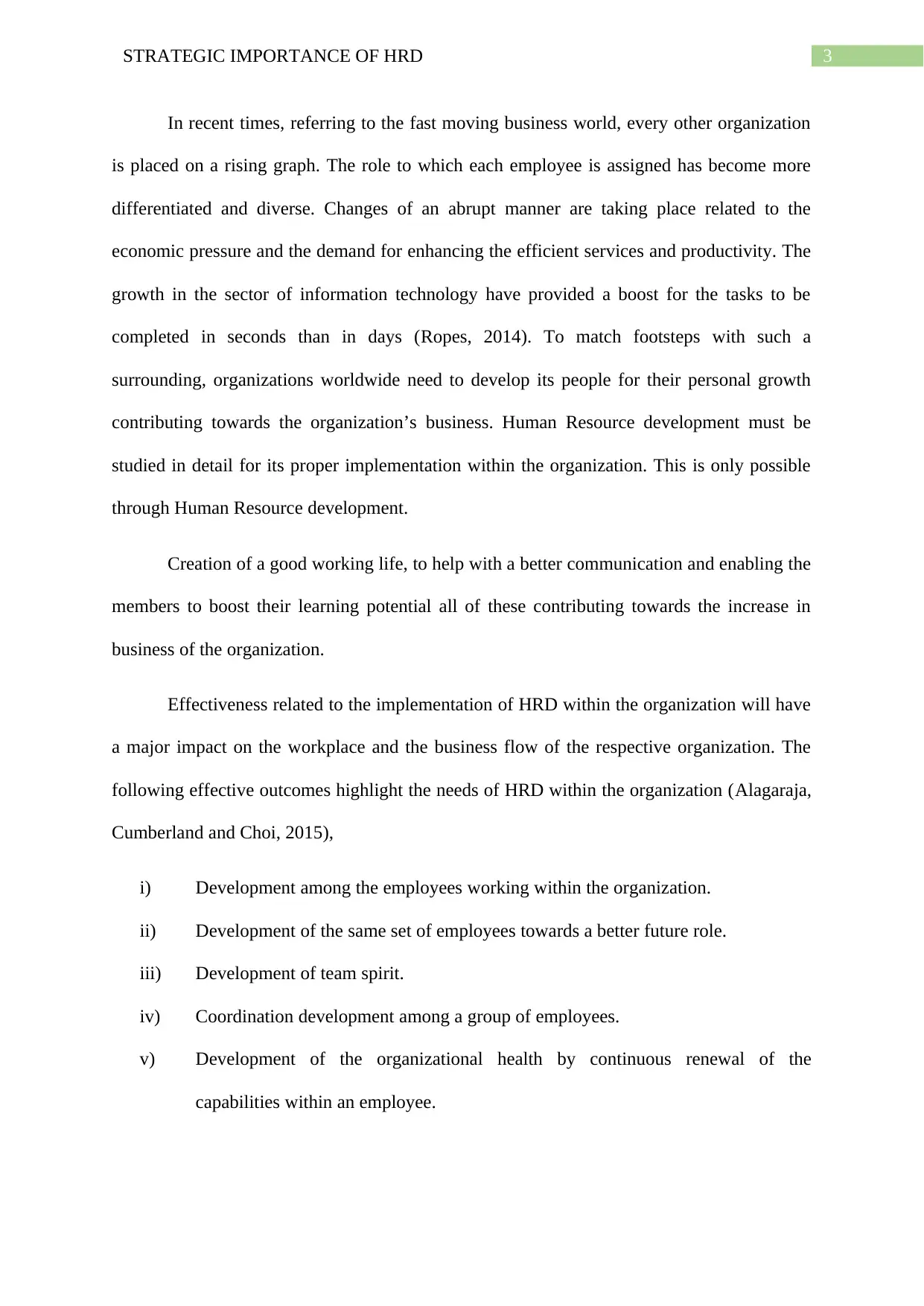
3STRATEGIC IMPORTANCE OF HRD
In recent times, referring to the fast moving business world, every other organization
is placed on a rising graph. The role to which each employee is assigned has become more
differentiated and diverse. Changes of an abrupt manner are taking place related to the
economic pressure and the demand for enhancing the efficient services and productivity. The
growth in the sector of information technology have provided a boost for the tasks to be
completed in seconds than in days (Ropes, 2014). To match footsteps with such a
surrounding, organizations worldwide need to develop its people for their personal growth
contributing towards the organization’s business. Human Resource development must be
studied in detail for its proper implementation within the organization. This is only possible
through Human Resource development.
Creation of a good working life, to help with a better communication and enabling the
members to boost their learning potential all of these contributing towards the increase in
business of the organization.
Effectiveness related to the implementation of HRD within the organization will have
a major impact on the workplace and the business flow of the respective organization. The
following effective outcomes highlight the needs of HRD within the organization (Alagaraja,
Cumberland and Choi, 2015),
i) Development among the employees working within the organization.
ii) Development of the same set of employees towards a better future role.
iii) Development of team spirit.
iv) Coordination development among a group of employees.
v) Development of the organizational health by continuous renewal of the
capabilities within an employee.
In recent times, referring to the fast moving business world, every other organization
is placed on a rising graph. The role to which each employee is assigned has become more
differentiated and diverse. Changes of an abrupt manner are taking place related to the
economic pressure and the demand for enhancing the efficient services and productivity. The
growth in the sector of information technology have provided a boost for the tasks to be
completed in seconds than in days (Ropes, 2014). To match footsteps with such a
surrounding, organizations worldwide need to develop its people for their personal growth
contributing towards the organization’s business. Human Resource development must be
studied in detail for its proper implementation within the organization. This is only possible
through Human Resource development.
Creation of a good working life, to help with a better communication and enabling the
members to boost their learning potential all of these contributing towards the increase in
business of the organization.
Effectiveness related to the implementation of HRD within the organization will have
a major impact on the workplace and the business flow of the respective organization. The
following effective outcomes highlight the needs of HRD within the organization (Alagaraja,
Cumberland and Choi, 2015),
i) Development among the employees working within the organization.
ii) Development of the same set of employees towards a better future role.
iii) Development of team spirit.
iv) Coordination development among a group of employees.
v) Development of the organizational health by continuous renewal of the
capabilities within an employee.
Paraphrase This Document
Need a fresh take? Get an instant paraphrase of this document with our AI Paraphraser

4STRATEGIC IMPORTANCE OF HRD
vi) Training provided by the organization that will keep the employees of the
company known to the newer technologies, hence increasing the business flow.
vii) Provisioning the employees for attainment of self-actualization.
Comprehension of Human Resource Development
The dire need for HRD implementation within an organization is to cope up with the
rapidly changing environment. This process helps in developing and unleashing human
expertise aiming towards the improvement in performance within the organization through
Organization Development (OD) and employee training and development. Hence, in rapid
changing environment, organizations have successfully implemented the HRD within the
system keeping in mind the long-term strategies to cope up with the external changes in the
environment taking place in the near future.
Taking into consideration the emerging strategic movement within the modern
organizations, there is a huge demand for strategic steering of managerial practices within the
strategic movement. HRD policy being the most effective way in making the organization run
in a lot more smoother way. Integration of the HRD policy along with the organizational
strategy refers itself as a precursor towards the effective execution of the Strategic movement.
Both of the organizations belonging to the private and the public sector are in need of positive
factors concerned towards the successful execution of organization’s aims and strategies
(Yorks and Barto, 2014). The HRD framework includes within itself all of the development
features that can lead to the development of an employee as well as the of the business the
organization is working upon.
The implementation of HRD can divided into stages. The first stage refers to the
procedure for checking the needs and to look for the areas which need a development to serve
the purpose in a much better way. The next step refers to the process of designing the HRD
vi) Training provided by the organization that will keep the employees of the
company known to the newer technologies, hence increasing the business flow.
vii) Provisioning the employees for attainment of self-actualization.
Comprehension of Human Resource Development
The dire need for HRD implementation within an organization is to cope up with the
rapidly changing environment. This process helps in developing and unleashing human
expertise aiming towards the improvement in performance within the organization through
Organization Development (OD) and employee training and development. Hence, in rapid
changing environment, organizations have successfully implemented the HRD within the
system keeping in mind the long-term strategies to cope up with the external changes in the
environment taking place in the near future.
Taking into consideration the emerging strategic movement within the modern
organizations, there is a huge demand for strategic steering of managerial practices within the
strategic movement. HRD policy being the most effective way in making the organization run
in a lot more smoother way. Integration of the HRD policy along with the organizational
strategy refers itself as a precursor towards the effective execution of the Strategic movement.
Both of the organizations belonging to the private and the public sector are in need of positive
factors concerned towards the successful execution of organization’s aims and strategies
(Yorks and Barto, 2014). The HRD framework includes within itself all of the development
features that can lead to the development of an employee as well as the of the business the
organization is working upon.
The implementation of HRD can divided into stages. The first stage refers to the
procedure for checking the needs and to look for the areas which need a development to serve
the purpose in a much better way. The next step refers to the process of designing the HRD
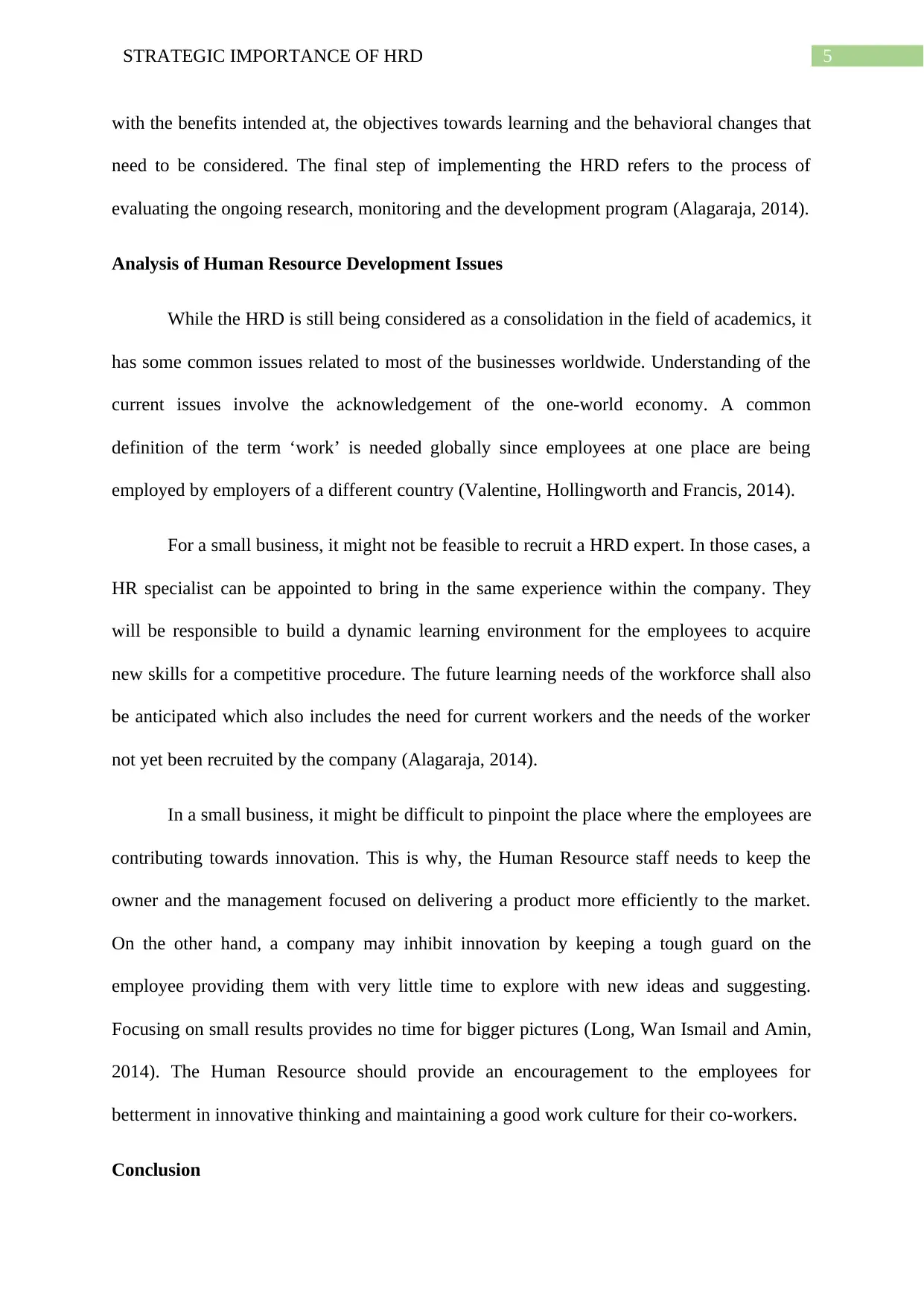
5STRATEGIC IMPORTANCE OF HRD
with the benefits intended at, the objectives towards learning and the behavioral changes that
need to be considered. The final step of implementing the HRD refers to the process of
evaluating the ongoing research, monitoring and the development program (Alagaraja, 2014).
Analysis of Human Resource Development Issues
While the HRD is still being considered as a consolidation in the field of academics, it
has some common issues related to most of the businesses worldwide. Understanding of the
current issues involve the acknowledgement of the one-world economy. A common
definition of the term ‘work’ is needed globally since employees at one place are being
employed by employers of a different country (Valentine, Hollingworth and Francis, 2014).
For a small business, it might not be feasible to recruit a HRD expert. In those cases, a
HR specialist can be appointed to bring in the same experience within the company. They
will be responsible to build a dynamic learning environment for the employees to acquire
new skills for a competitive procedure. The future learning needs of the workforce shall also
be anticipated which also includes the need for current workers and the needs of the worker
not yet been recruited by the company (Alagaraja, 2014).
In a small business, it might be difficult to pinpoint the place where the employees are
contributing towards innovation. This is why, the Human Resource staff needs to keep the
owner and the management focused on delivering a product more efficiently to the market.
On the other hand, a company may inhibit innovation by keeping a tough guard on the
employee providing them with very little time to explore with new ideas and suggesting.
Focusing on small results provides no time for bigger pictures (Long, Wan Ismail and Amin,
2014). The Human Resource should provide an encouragement to the employees for
betterment in innovative thinking and maintaining a good work culture for their co-workers.
Conclusion
with the benefits intended at, the objectives towards learning and the behavioral changes that
need to be considered. The final step of implementing the HRD refers to the process of
evaluating the ongoing research, monitoring and the development program (Alagaraja, 2014).
Analysis of Human Resource Development Issues
While the HRD is still being considered as a consolidation in the field of academics, it
has some common issues related to most of the businesses worldwide. Understanding of the
current issues involve the acknowledgement of the one-world economy. A common
definition of the term ‘work’ is needed globally since employees at one place are being
employed by employers of a different country (Valentine, Hollingworth and Francis, 2014).
For a small business, it might not be feasible to recruit a HRD expert. In those cases, a
HR specialist can be appointed to bring in the same experience within the company. They
will be responsible to build a dynamic learning environment for the employees to acquire
new skills for a competitive procedure. The future learning needs of the workforce shall also
be anticipated which also includes the need for current workers and the needs of the worker
not yet been recruited by the company (Alagaraja, 2014).
In a small business, it might be difficult to pinpoint the place where the employees are
contributing towards innovation. This is why, the Human Resource staff needs to keep the
owner and the management focused on delivering a product more efficiently to the market.
On the other hand, a company may inhibit innovation by keeping a tough guard on the
employee providing them with very little time to explore with new ideas and suggesting.
Focusing on small results provides no time for bigger pictures (Long, Wan Ismail and Amin,
2014). The Human Resource should provide an encouragement to the employees for
betterment in innovative thinking and maintaining a good work culture for their co-workers.
Conclusion
⊘ This is a preview!⊘
Do you want full access?
Subscribe today to unlock all pages.

Trusted by 1+ million students worldwide
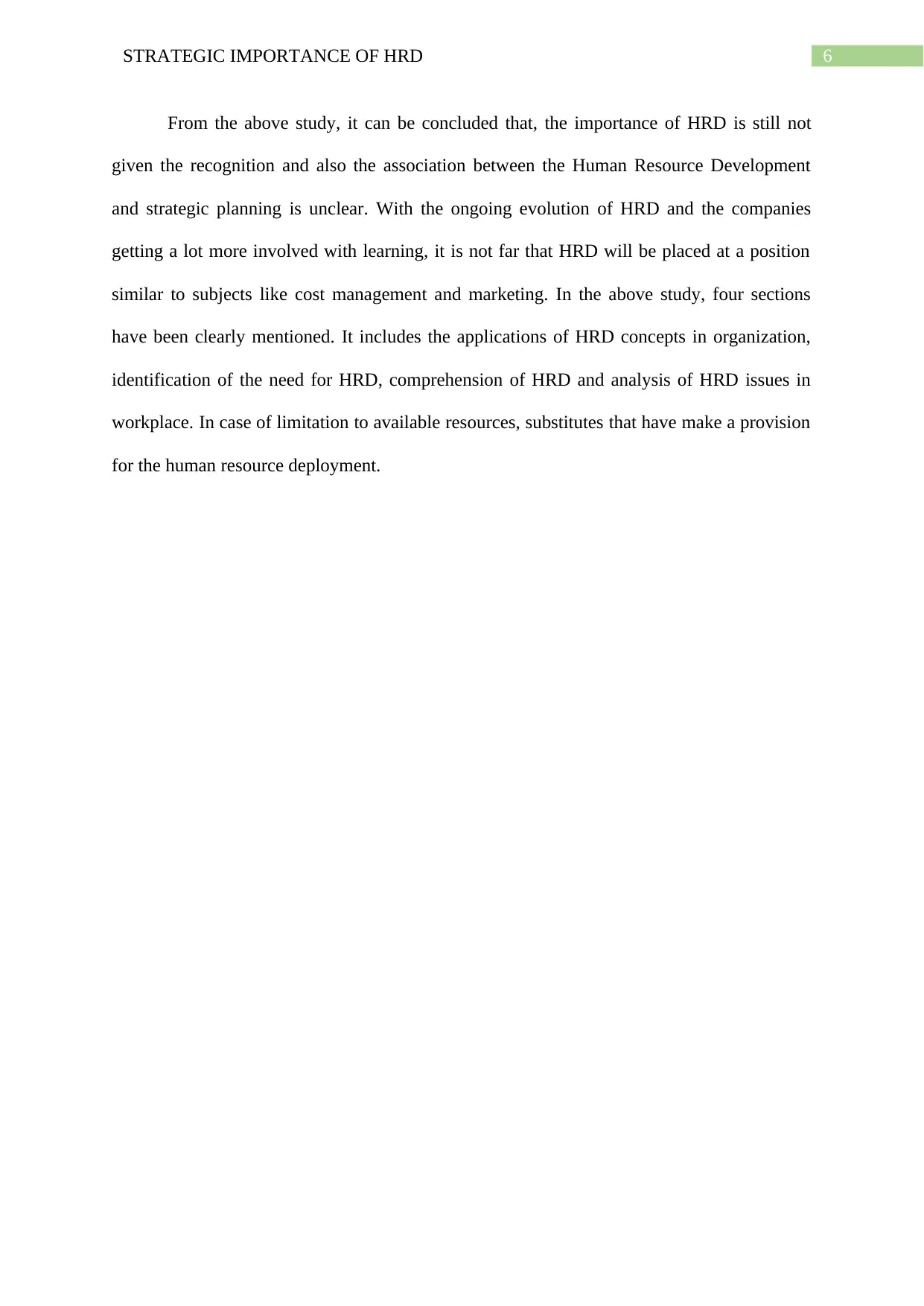
6STRATEGIC IMPORTANCE OF HRD
From the above study, it can be concluded that, the importance of HRD is still not
given the recognition and also the association between the Human Resource Development
and strategic planning is unclear. With the ongoing evolution of HRD and the companies
getting a lot more involved with learning, it is not far that HRD will be placed at a position
similar to subjects like cost management and marketing. In the above study, four sections
have been clearly mentioned. It includes the applications of HRD concepts in organization,
identification of the need for HRD, comprehension of HRD and analysis of HRD issues in
workplace. In case of limitation to available resources, substitutes that have make a provision
for the human resource deployment.
From the above study, it can be concluded that, the importance of HRD is still not
given the recognition and also the association between the Human Resource Development
and strategic planning is unclear. With the ongoing evolution of HRD and the companies
getting a lot more involved with learning, it is not far that HRD will be placed at a position
similar to subjects like cost management and marketing. In the above study, four sections
have been clearly mentioned. It includes the applications of HRD concepts in organization,
identification of the need for HRD, comprehension of HRD and analysis of HRD issues in
workplace. In case of limitation to available resources, substitutes that have make a provision
for the human resource deployment.
Paraphrase This Document
Need a fresh take? Get an instant paraphrase of this document with our AI Paraphraser

7STRATEGIC IMPORTANCE OF HRD
References
Alagaraja, M., 2014. A conceptual model of organizations as learning-performance systems:
Integrative review of lean implementation literature. Human Resource Development
Review, 13(2), pp.207-233.
Alagaraja, M., 2014. Mobilizing organizational alignment through strategic human resource
development. Human Resource Development International, 16(1), pp.74-93.
Alagaraja, M., Cumberland, D.M. and Choi, N., 2015. The mediating role of leadership and
people management practices on HRD and organizational performance. Human Resource
Development International, 18(3), pp.220-234.
Baek, P. and Kim, N., 2014. Exploring a theoretical foundation for HRD in society: Toward a
model of stakeholder-based HRD. Human Resource Development International, 17(5),
pp.499-513.
Lee, J., Zo, H. and Lee, H., 2014. Smart learning adoption in employees and HRD
managers. British Journal of Educational Technology, 45(6), pp.1082-1096.
Long, C.S., Wan Ismail, W.K. and Amin, S.M., 2014. The role of change agent as mediator
in the relationship between HR competencies and organizational performance. The
International Journal of Human Resource Management, 24(10), pp.2019-2033.
Muduli, A., 2015. High performance work system, HRD climate and organisational
performance: an empirical study. European journal of Training and development, 39(3),
pp.239-257.
Potnuru, R.K.G. and Sahoo, C.K., 2016. HRD interventions, employee competencies and
organizational effectiveness: an empirical study. European Journal of Training and
Development, 40(5), pp.345-365.
References
Alagaraja, M., 2014. A conceptual model of organizations as learning-performance systems:
Integrative review of lean implementation literature. Human Resource Development
Review, 13(2), pp.207-233.
Alagaraja, M., 2014. Mobilizing organizational alignment through strategic human resource
development. Human Resource Development International, 16(1), pp.74-93.
Alagaraja, M., Cumberland, D.M. and Choi, N., 2015. The mediating role of leadership and
people management practices on HRD and organizational performance. Human Resource
Development International, 18(3), pp.220-234.
Baek, P. and Kim, N., 2014. Exploring a theoretical foundation for HRD in society: Toward a
model of stakeholder-based HRD. Human Resource Development International, 17(5),
pp.499-513.
Lee, J., Zo, H. and Lee, H., 2014. Smart learning adoption in employees and HRD
managers. British Journal of Educational Technology, 45(6), pp.1082-1096.
Long, C.S., Wan Ismail, W.K. and Amin, S.M., 2014. The role of change agent as mediator
in the relationship between HR competencies and organizational performance. The
International Journal of Human Resource Management, 24(10), pp.2019-2033.
Muduli, A., 2015. High performance work system, HRD climate and organisational
performance: an empirical study. European journal of Training and development, 39(3),
pp.239-257.
Potnuru, R.K.G. and Sahoo, C.K., 2016. HRD interventions, employee competencies and
organizational effectiveness: an empirical study. European Journal of Training and
Development, 40(5), pp.345-365.
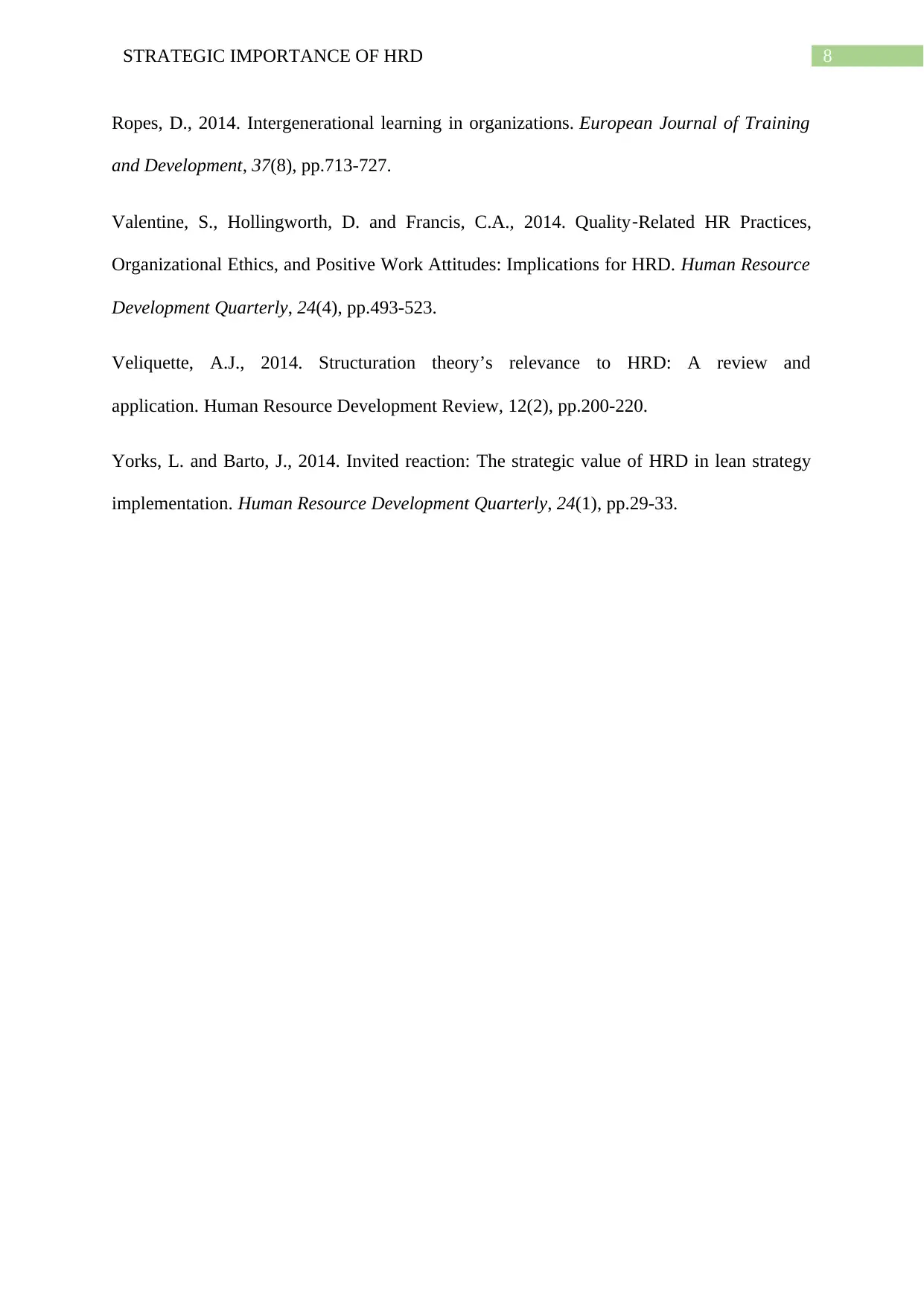
8STRATEGIC IMPORTANCE OF HRD
Ropes, D., 2014. Intergenerational learning in organizations. European Journal of Training
and Development, 37(8), pp.713-727.
Valentine, S., Hollingworth, D. and Francis, C.A., 2014. Quality‐Related HR Practices,
Organizational Ethics, and Positive Work Attitudes: Implications for HRD. Human Resource
Development Quarterly, 24(4), pp.493-523.
Veliquette, A.J., 2014. Structuration theory’s relevance to HRD: A review and
application. Human Resource Development Review, 12(2), pp.200-220.
Yorks, L. and Barto, J., 2014. Invited reaction: The strategic value of HRD in lean strategy
implementation. Human Resource Development Quarterly, 24(1), pp.29-33.
Ropes, D., 2014. Intergenerational learning in organizations. European Journal of Training
and Development, 37(8), pp.713-727.
Valentine, S., Hollingworth, D. and Francis, C.A., 2014. Quality‐Related HR Practices,
Organizational Ethics, and Positive Work Attitudes: Implications for HRD. Human Resource
Development Quarterly, 24(4), pp.493-523.
Veliquette, A.J., 2014. Structuration theory’s relevance to HRD: A review and
application. Human Resource Development Review, 12(2), pp.200-220.
Yorks, L. and Barto, J., 2014. Invited reaction: The strategic value of HRD in lean strategy
implementation. Human Resource Development Quarterly, 24(1), pp.29-33.
⊘ This is a preview!⊘
Do you want full access?
Subscribe today to unlock all pages.

Trusted by 1+ million students worldwide
1 out of 9
Related Documents
Your All-in-One AI-Powered Toolkit for Academic Success.
+13062052269
info@desklib.com
Available 24*7 on WhatsApp / Email
![[object Object]](/_next/static/media/star-bottom.7253800d.svg)
Unlock your academic potential
Copyright © 2020–2025 A2Z Services. All Rights Reserved. Developed and managed by ZUCOL.




